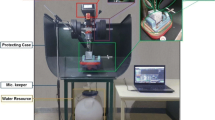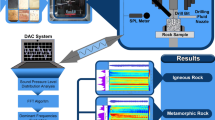Abstract
Evaluating the physical and mechanical properties of materials such as rock or concrete is among the most significant issues in engineering studies. Measurement of the properties of the rocks either in the laboratory or in the field needs the standards and specific methods. Also, most of these tests need time and a large number of rock samples. Therefore, finding a method that can be accurately, quickly, and reliably predict the properties of rocks will provide a great advance in the quality of studies before or during the projects. The purpose of this paper is to find a method for predicting and determining the geomechanical properties of hard rocks during the drilling operation. For this purpose, after the preparation of the rock samples, acoustic and vibration signals propagated during the drilling process were recorded and processed. After analysing the acoustic and vibration signals, statistical analysis for investigation of the relationship between the properties of the rocks and the acoustic parameters was performed. Sound Pressure Level (SPL), First Dominant Frequency (FDF), and Vibration Level (VL) were selected as predictor variables for measuring and predicting Uniaxial Compressive Strength (UCS), Brazilian Tensile strength (BTS) and Schmidt rebound number (SRN) by multivariable regression. Results of statistical analysis show that there is an acceptable correlation coefficient between rock properties and properties of acoustic and vibration signals of the rock drilling operation. Hence, this method can be used as a relatively inexpensive, non-destructive, reliable and real-time method in large-scale mining or civil operation for predicting the rock properties.





Similar content being viewed by others
References
Bastari A, Cristalli C, Morlacchi R, Pomponi E (2011) Acoustic emissions for particle sizing of powders through signal processing techniques. Mech Syst Signal Process 25:901–916
Flegner P, Kačur J, Durdán M, Leššo I, Laciak M (2014) Measurement and processing of vibro-acoustic signal from the process of rock disintegration by rotary drilling. Measurement 56:178–193
Gómez MP, Hey AM, Ruzzante JE, D’Attellis CE (2010) Tool wear evaluation in drilling by acoustic emission. Phys Procedia 3:819–825
Goyal D, Pabla B (2016) The vibration monitoring methods and signal processing techniques for structural health monitoring: a review. Arch Comput Methods Eng 23:585–594
Gradl C, Eustes AW, Thonhauser G (2012) An analysis of noise characteristics of drill bits. J energy resour technol 134:013103
Katoh K, Misawa K, Ki K, Miyata T (2002) MAFFT a novel method for rapid multiple sequence alignment based on fast. Fourier transform Nucleic acids Res 30(14):3059–3066
Kawasaki S, Tanimoto C, Koizumi K, Ishikawa M (2002) An attempt to estimate mechanical properties of rocks using the Equotip hardness tester . J Jap Soc Eng Geol 43:244–248
Khoshouei M, Bagherpour R (2019) Application of acoustic emission (AE) in mining and earth sciences: a review. Rudarsko-geološko-naftni zbornik 34(4):19–31
Khoshouei M, Bagherpour R, Jalalian MH, Yari M (2020) Investigating the acoustic signs of different rock types based on the values of acoustic signal RMS the mining-geology-petroleum. Eng Bull 35(3):29–38
Krúpa V, Kruľáková M, Lazarová E, Labaš M, Feriančiková K, Ivaničová L (2018) Measurement, modeling and prediction of penetration depth in rotary drilling of rocks. Measurement 117:165–175
Kumar BR, Vardhan H, Govindaraj M (2011) Prediction of uniaxial compressive strength, tensile strength and porosity of sedimentary rocks using sound level produced during rotary drilling. Rock Mech Rock Eng 44:613–620
Lakshminarayana CR, Tripathi AK, Pal SK (2020) Prediction of mechanical properties of sedimentary type rocks using rotary drilling parameters. Geotech Geol Eng 38:4863–4876
Nussbaumer HJ (2012) Fast fourier transform and convolution algorithms. Sci Business Media, London
Qin M, Wang K, Pan K, Sun T, Liu Z (2018) Analysis of signal characteristics from rock drilling based on vibration and acoustic sensor approaches. Appl Acoust 140:275–282
Rencher, A. C. (2003) Methods of multivariate analysis, Vol. 492. John Wiley & Sons
Rivero Ad, Lacalle LL, Penalva ML (2008) Tool wear detection in dry high-speed milling based upon the analysis of machine internal signals. Mechatronics 18(627):633
Schön JH (2015) Physical properties of rocks. In: Schon JH (ed) Fundamentals and principles of petrophysics, 2nd edn. Elsevier, Austria
Seto M, Nag D, Vutukuri VJG, Engineering G (1999) In-situ rock stress measurement from rock cores using the acoustic emission method and deformation rate analysis. Geotech Geol Eng 17(241):266
Sheng M, Tian S, Zhang B, Ge H (2019) Frequency analysis of multi-sources acoustic emission from high-velocity waterjet rock drilling and its indicator to drilling efficiency. Int J Rock Mech Min Sci 115:137–144
Singh R, Umrao RK, Ahmad M, Ansari M, Sharma L, Singh TJM (2017) Prediction of geomechanical parameters using soft computing and multiple regression approach. Measurement 99:108–119
Toh C (2004) Vibration analysis in high speed rough and finish milling hardened steel. J Sound Vib 278:101–115
Vardhan H, Adhikari G, Raj MG (2009) Estimating rock properties using sound levels produced during drilling. Int J Rock Mech Min Sci 46:604–612
Voznesenskii AS, Krasilov MN, Kutkin YO, Tavostin MN, Osipov YV (2017) Features of interrelations between acoustic quality factor and strength of rock salt during fatigue cyclic loadings. Int J Fatigue 97:70–78
Welch P (1967) The use of fast fourier transform for the estimation of power spectra a method based on time averaging over short modified periodograms. IEEE Trans audio electroacoust 15(2):70–73
Williams E, Hagan P (2006) Observations on the variation in acoustic emissions with changes in rock cutting conditions. Paper presented at the Coal Operators' Conference
Xiao Y, Hurich C, Molgaard J, Butt SD (2018) Investigation of active vibration drilling using acoustic emission and cutting size analysis . J Rock Mech Geotech Eng 10:390–401
Yari M, Bagherpour R (2018a) Implementing acoustic frequency analysis for development the novel model of determining geomechanical features of igneous rocks using rotary drilling device . Geotech Geol Eng 36:1805–1816
Yari M, Bagherpour R, Khoshouei M (2019) Developing a novel model for predicting geomechanical features of carbonate rocks based on acoustic frequency processing during drilling . Bulletin Eng Geol Environ 78(3):1747–1759
Yari M, Bagherpour R (2018b) Investigating an innovative model for dimensional sedimentary rocks characterization using acoustic frequencies analysis during drilling. Rudarsko-geološko-naftni zbornik 33(2):17–25
Zhang Z, Zhang R, Xie H, Liu J, Were P (2015) Differences in the acoustic emission characteristics of rock salt compared with granite and marble during the damage evolution process. Environ earth sci 73:6987–6999
Author information
Authors and Affiliations
Contributions
Mehrbod Khoshouei performed the design, analyzed the results, implementation of the research and contributed to the writing of the manuscript, and Raheb Bagherpour analyzed the results and contributed to the writing of the manuscript and to the Reviewing and Editing.
Corresponding author
Additional information
Publisher's Note
Springer Nature remains neutral with regard to jurisdictional claims in published maps and institutional affiliations.
Rights and permissions
About this article
Cite this article
Khoshouei, M., Bagherpour, R. Predicting the Geomechanical Properties of Hard Rocks Using Analysis of the Acoustic and Vibration Signals During the Drilling Operation. Geotech Geol Eng 39, 2087–2099 (2021). https://doi.org/10.1007/s10706-020-01611-z
Received:
Accepted:
Published:
Issue Date:
DOI: https://doi.org/10.1007/s10706-020-01611-z




